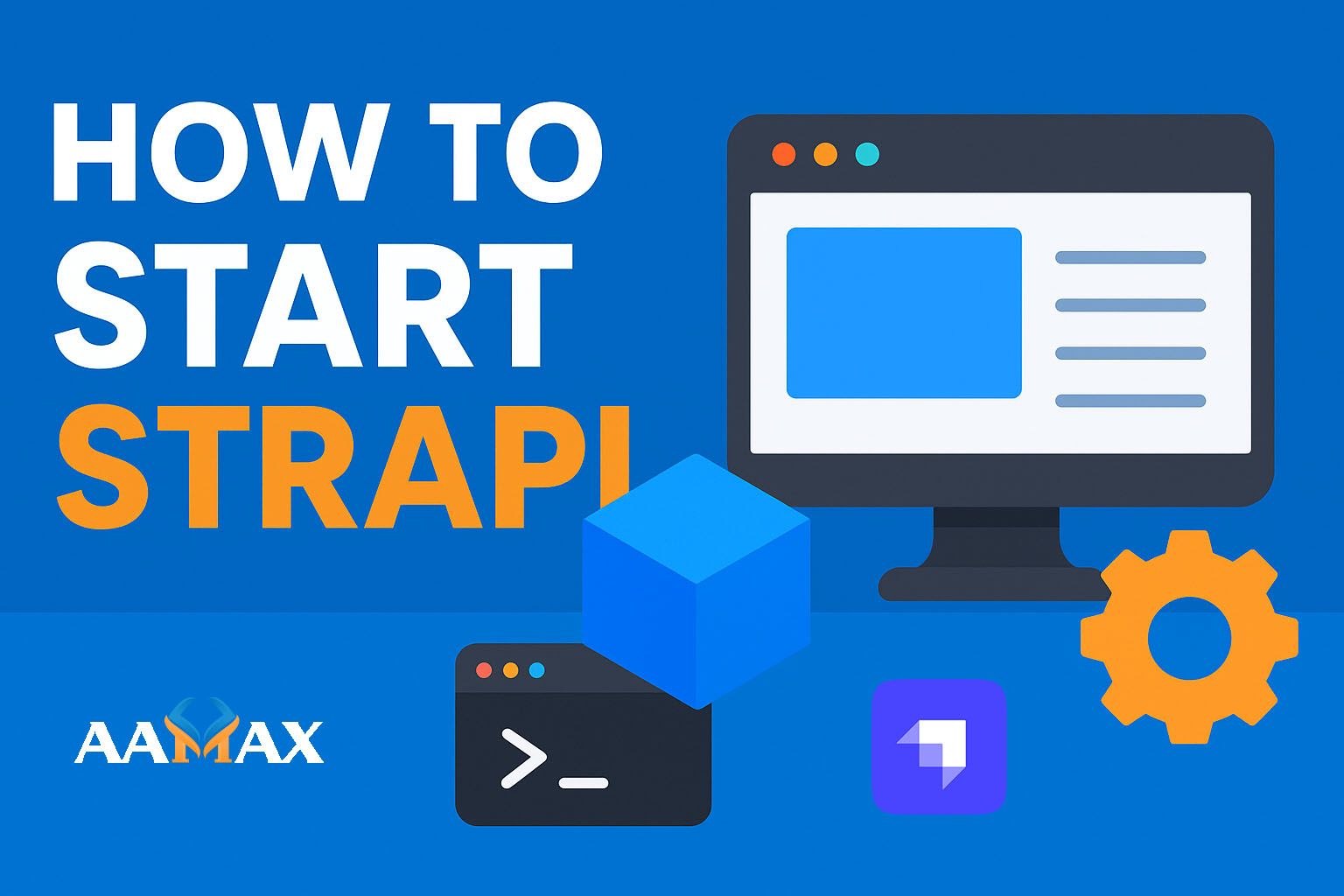
How to Start Strapi
Strapi has become one of the most popular headless CMS platforms in the MERN ecosystem --- and for good reason. It's flexible, open‑source, API‑driven, and perfect for developers who want full control over their backend without dealing with the limitations of traditional CMS platforms. Whether you're building a blog, an enterprise dashboard, an eCommerce API, or a mobile app backend, Strapi gives you a scalable foundation.
This in‑depth guide walks you through how to start Strapi from scratch, covering installation, configuration, project structuring, deployment options, and best practices. It is specifically designed for beginners, agencies, and MERN developers looking to improve their backend workflow.
If you want expert assistance with Strapi development or MERN stack projects in general, you can hire AAMAX --- a full‑service digital marketing and development company offering Web Development, Digital Marketing, and SEO services.
What Is Strapi?
Strapi is an open‑source headless CMS that allows developers to build APIs quickly while maintaining full control over data models, permissions, and the underlying code. It is built using Node.js and supports both REST and GraphQL APIs.
Key Features of Strapi
- Headless architecture --- decoupled frontend and backend\
- Customizable APIs with full access to code\
- Built-in user authentication & role permissions\
- Plugin system for extending functionality\
- Database flexibility (SQLite, MongoDB, PostgreSQL, MySQL)\
- Admin panel customization\
- Strong community and ecosystem
Why Choose Strapi for Your Next Project?
Before jumping into installation, understanding the benefits is important.
1. Developer-Friendly
Strapi is built for developers who want to write clean, customizable backend logic. You're not restricted by closed‑source systems.
2. API‑Driven by Default
Every content type you create automatically generates REST and optionally GraphQL endpoints.
3. Self‑Hosted and Secure
You maintain full control of your data and deployment environment.
4. Perfect for MERN / JAMStack Projects
Strapi works extremely well with React, Next.js, Vue, Nuxt, Flutter, and mobile apps.
5. Customizable Admin Panel
You can extend the dashboard, add custom fields, write plugins, and tailor it to your workflow.
Prerequisites to Start Strapi
Before installing Strapi, ensure your environment is ready.
System Requirements
- Node.js v18+
- npm or yarn
- A database (SQLite works for development)
- Git installed (optional but recommended)
Recommended Tools
- VS Code (or any code editor)
- Insomnia / Postman for testing APIs
- MongoDB/PostgreSQL for production-level apps
How to Start Strapi --- Step-by-Step Guide
This section covers everything from installation to creating your first content type.
Step 1: Install Strapi
Open your terminal and run:
npx create-strapi-app@latest my-project --quickstart
This installs Strapi with: - SQLite (default database) - Auto‑generated admin dashboard - Development server running automatically
Once installation completes, Strapi opens the browser at:
http://localhost:1337/admin
Create your admin account, and you're ready to start.
Step 2: Explore the Admin Dashboard
The Strapi admin panel is intuitive. From here you can:
- Create content types
- Manage users and permissions
- Upload media files
- Install plugins
- Configure settings
Key Sections
1. Content-Type Builder
This is where you build the structure of your API. Strapi generates endpoints automatically.
2. Content Manager
View, create, and edit entries from any content type.
3. Plugins
You can install plugins like: - GraphQL - SEO plugin - Documentation generator - Email provider integrations
4. Settings
Configure: - API tokens\
- Roles and permissions\
- Email provider\
- Webhooks\
- Authentication
Step 3: Create Your First Content Type
Let's create a "Blog Post" model.
Go to:
Content-Type Builder → Create New Collection Type
Add fields such as: - Title (Text) - Slug (UID) - Description (Rich Text) - Cover Image (Media) - PublishedAt (Date)
Save it and Strapi restarts automatically.
Auto-Generated API Endpoints
REST API:
GET /api/blog-posts
POST /api/blog-posts
GET /api/blog-posts/:id
If GraphQL plugin is installed:
query {
blogPosts {
data {
id
attributes {
title
description
}
}
}
}
Step 4: Add Content to Your API
Go to Content Manager → Select "Blog Posts"
Create your first post and save it.
Initially, APIs are restricted. You need to configure permissions.
Step 5: Enable Public API Access
Go to:
Settings → Roles → Public
Allow: - find - findOne
Save changes and test your API at:
http://localhost:1337/api/blog-posts
You'll now receive JSON data with your blog post.
Step 6: Connect Strapi with a Frontend (React / Next.js / MERN)
Using Strapi with a frontend is straightforward.
Example: Fetch Data in React
import { useEffect, useState } from "react";
export default function Blog() {
const [blogs, setBlogs] = useState([]);
useEffect(() => {
fetch("http://localhost:1337/api/blog-posts?populate=*")
.then(res => res.json())
.then(data => setBlogs(data.data));
}, []);
return (
<div>
<h1>Blogs</h1>
{blogs.map(blog => (
<h2 key={blog.id}>{blog.attributes.title}</h2>
))}
</div>
);
}
Next.js (App Router)
export async function getData() {
const res = await fetch("http://localhost:1337/api/blog-posts?populate=*");
return await res.json();
}
Step 7: Upload Media & Configure File Storage
Strapi supports: - Local uploads - Cloudinary - AWS S3 - DigitalOcean Spaces
For production, always choose cloud storage.
Step 8: Install Helpful Plugins
Recommended Plugins
- GraphQL
- Documentation Generator
- SEO plugin
- CKEditor / Advanced Markdown Editor
- Email Designer
Install using:
npm install @strapi/plugin-graphql
Restart Strapi to activate.
Step 9: Deploy Strapi
You can deploy Strapi on:
VPS Hosting
Ideal for full control: - DigitalOcean - Linode - AWS EC2
PaaS Hosting
Easy deployment: - Render - Railway - Heroku (legacy)
Static Frontend + Strapi Backend
Perfect for MERN and JAMStack.
Before deployment, configure: - Production database - CORS - API tokens - Environment variables
Step 10: Best Practices When Starting Strapi
Follow these principles for a clean, scalable project:
1. Use Environment Variables
Store secrets in .env:
DATABASE_PASSWORD=
JWT_SECRET=
API_TOKEN_SALT=
2. Use PostgreSQL for Production
SQLite is not recommended beyond development.
3. Keep Models Organized
Group content types logically: - Blog - Products - Categories - Users
4. Use API Tokens for Frontend Requests
Avoid exposing admin tokens.
5. Keep Strapi Updated
New security patches and features are released frequently.
6. Generate API Documentation
Use the documentation plugin for better team collaboration.
When Should You Use Strapi?
Strapi is ideal for:
- Blogs & news portals\
- E-commerce APIs\
- Mobile app backends\
- Multi‑vendor marketplace systems\
- Educational platforms\
- Real estate listings\
- Company websites\
- Custom dashboards
Strapi gives you the power of a CMS with the flexibility of a modern Node.js backend.
Common Mistakes Beginners Make
1. Using SQLite in Production
Always switch to PostgreSQL for scaling.
2. Giving Public Role Too Many Permissions
This exposes your API to attacks.
3. Storing Images Locally in Production
Use a cloud storage provider.
4. Not Using API Tokens
Admin tokens are highly sensitive.
5. Misunderstanding Collections vs. Single Types
- Collections = multiple entries (blogs, products)\
- Single Types = unique pages (home, about)
Tips to Build Faster with Strapi
- Use templates for repeating fields\
- Enable GraphQL for structured queries\
- Use component-based content modeling\
- Use relation fields for complex structures\
- Automate repetitive tasks using lifecycle hooks\
- Use plugins to extend the admin panel
Should You Use Strapi for Client Projects?
Absolutely. It is especially strong for: - Small to medium businesses\
- Agencies building multiple websites\
- Developers who want fast API development\
- MERN stack apps needing a robust backend
AAMAX specializes in MERN and Strapi‑based development, so if you need expert help setting up a full backend, integrating Strapi with Next.js, or building custom features, they are a reliable partner.
Final Thoughts
Starting Strapi is easier than ever. With its flexible architecture, rich plugin ecosystem, and strong developer‑friendly design, Strapi empowers you to build modern, scalable APIs without learning complex backend frameworks. Whether you're a beginner or a professional agency, understanding the fundamentals covered in this guide will help you build strong, production‑ready Strapi applications.
If you need professional help developing your Strapi or MERN Stack Development, consider working with AAMAX --- a trusted full‑service digital marketing, web development, and SEO company.







